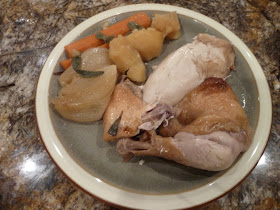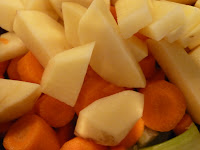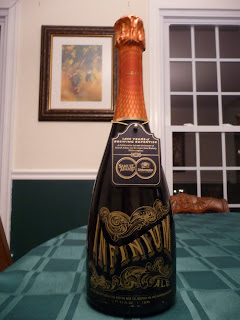After having Hushuur in Mongolia, my culinary adventures take me half-way around the world to ... Cuba. The cuisine of Cuba reflects its history and culture, influenced by a melange of Caribbean, Spanish and African foods and cooking techniques. The European influences are more predominant in Western Cuba, while the Caribbean and African influences are more present in Eastern Cuba. And, for my personal culinary challenge, I decided to draw from the entire island with a main dish of Ropa Vieja, with a side of Congri (red beans and rice). And, for good measure, I decided that I would also make my own Cuban sofrito.
I've had Ropa Vieja at Cuban or Latin American restaurants before, so the dish is not new to me. However, I've never made that dish before. I have also never made Congri or my own Cuban sofrito before. So, this challenge represents some firsts for me and, as you will see, there will not be any lasts.
THE MAIN DISH
Ropa Vieja means "old clothes" in Spanish and it is a dish that is not only enjoyed in Cuba, but also in Panama, the Dominican Republic and Puerto Rico. This dish originated in the Canary Islands of Spain, which served as the last stop before the voyage to the Caribbean and the first stop when returning from the Caribbean. In the Canary Islands, the dish was made with beef, chicken or pork, with garbanzo beans and potatoes. However, in Cuba, it is just made with the meat, no beans or potatoes are added.
In making this dish, I worked off of two recipes, which had different ways of preparing the dish. The first way to prepare the dish (which is done by 3 Guys from Miami) is to prepare the meat separately from the sauce. The second way (which is done by Taste of Cuba) is to prepare the meat and cook it in the sauce. The second recipe also included the use of sofrito, which I wanted to make as part of this challenge. So, I combined both recipes, by first preparing the meat separately by simmering it in a broth with vegetables for a couple of hours and then preparing the sauce in the same pot, thereby enabling me to use the broth and browned bits in the sauce. I also used some sofrito, in addition to the vegetables called for in the recipe, to give extra flavor to the sauce.
ROPA VIEJA
Serves 4 to 6
Ingredients (for the beef):
2 pounds of flank steak
5 tablespoons of olive oil
1 large onion, sliced
1 green pepper, diced
5 cloves of garlic, chopped
Flour for dusting
Ingredients (for the sauce):
2 onions, diced
2 green peppers, diced
1 can of crushed tomatoes
4 ounces tomato paste
4 cloves of garlic, mashed with 1 teaspoon of salt
1 cup of red wine (I used Tempranillo)
1 bay leaf
2 teaspoons of ground cumin
Olive oil for sauteing
Salt, to taste
Black pepper, to taste
6 ounces of sofrito (see recipe below)
Directions:
1. Brown the flank steak. Dust the flank steak with flour, as well as salt and pepper the beef. Heat the olive oil to medium high. Brown the flank steak in a dutch oven or a deep cast iron pot.
2. Simmer the steak with the vegetables. Add enough water to surround the meat without covering it. Add the onion, garlic and green pepper. Simmer covered for about two hours.
3. Shred the steak. When the meat is fork tender, then it is done. Remove the meat to a platter and shred it. Discard the vegetables but save the broth.
4. Prepare the sauce. In the same pot that you cooked the meat, add additional olive oil for sauteing and heat to medium high. Add the sofrito, along with the onions, garlic, and green pepper. Saute until all of the vegetables are tender, which should be about ten minutes. Add the tomato paste, crushed tomatoes, cumin, red wine and bay leaf. Also add a few ladles of the broth. Salt and pepper to taste. Let the sauce simmer for ten minutes. Add the shredded beef and continue to simmer for about ten more minutes.
Ropa Vieja is usually served with or on top of rice. As with prior challenges, I try to make a complete meal whenever I can, including side dishes and beverages if possible. One of the most common rice and bean dishes is Moros y Christianos (Moors & Christians), which is made with black beans and white rice. However, as I noted above, I wanted to draw from the entire island of Cuba with this challenge. The Ropa Vieja, with its European history, represents the western part of Cuba. I needed a recipe that represents Cuba Oriente, or the eastern part of Cuba.
So, I decided to make Congri, which is a variant of Moros y Christianos. Instead of using black beans, recipes for Congri call for the use of red beans. This dish is very easy to make, especially if you use canned beans instead of dried beans, which saves time in terms of cooking the beans. It is also a very fragrant dish, as the oregano and thyme, combined with the tomatoes, will fill the kitchen with wonderful scents.
CONGRI (Cuban Red Beans and Rice)
Serves 4 to 6
Ingredients:
2 cups red beans
2-3 tablespoons of olive oil
1 onion, finely chopped
2-3 garlic cloves, minced
1 teaspoon dried thyme
2 teaspoons dried oregano
1 bay leaf
1 cup of rice
1 3/4 cup of chicken broth
1 tablespoon of red wine vinegar
Directions:
1. Saute the vegetables. Heat the oil in a large saucepan over medium flame. Add the onion and
bell pepper and sauté until the onion is translucent. Add the garlic and
sauté for another 1 to 2 minutes.
2. Add ingredients. Add the tomato sauce, beans and herbs. Simmer for ten minutes.
3. Add more ingredients. Stir in the rice, broth and vinegar. Season everything with salt and ground pepper. Bring to a boil and the reduce, cover and simmer for about fifteen to eighteen minutes.
4. Let the rice stand. Remove from the heat and let stand for five to ten minutes. Stir lightly and serve.
THE EXTRA
A sofrito is the term for the combination of finely cut ingredients that are sauteed in oil. In Spanish cooking, a sofrito is the combination of garlic, onions and tomato, which are sauteed for a period of time in olive oil. In Cuba, a sofrito has one additional ingredient ... green bell peppers. You could also add other ingredients, such as white wine, cumin or cilantro, but the basic recipe calls for five ingredients: garlic, onion, tomato, bell pepper and olive oil. So, I stuck with that recipe, which is used by cooks and chefs as the basis for many dishes, including Ropa Vieja.
CUBAN SOFRITO
Makes 1 1/2 cups
Ingredients:
1 tomato, seeded and diced
1 onion, finely diced
1 green pepper, finely diced
1/8 cup of olive oil
2-3 garlic cloves, minced
1/4 cup olive oil
Directions:
1. Saute the vegetables. Heat 1/8 of a cup of olive oil over medium. Add the onions and garlic. Saute until the onions are translucent.
2. Continue to cook the vegetables. Add the diced tomato. Stir and continue to cook until it reduces a little.
3. Add olive oil. Remove heat and stir in the 1/4 cup of olive oil.
Overall, I think this meal was a great success. I was able to prepare the Vieja Ropa very well, cooking the flank steak to a point that it shredded easily. Preparing the flank steak separately from the sauce also made the whole process a lot easier, reducing the mess of trying to pull the steak out of the sauce to shred it. It also provided me with an additional ingredient to flavor the sauce, namely the broth in which the steak and vegetables had been cooking for two hours. And, as for the final product, the Vieja Ropa was very good, the cumin balanced well with the tomato, although the flank steak was a little chewy.
The Congri was excellent. The rice was cooked perfectly and was a very good counterpart to the red beans. This dish can be modified to make it vegetarian by substituting vegetable broth or vegetable stock for chicken broth. You could also use water instead of broth or stock, although I think that will lessen the favor of the dish. I will definitely make this meal again, especially the Congri. Until next time....
ENJOY!
For more information on Ropa Vieja, check out
Wikipedia and for more information on sofrito, check out
Wikipedia.









































